Jetsam
Tom Jenkins, Eric Paulos
Intel Research, September 2004
Go directly to Jetsam - Digital Trash
ACM SIGCHI paper presented at the CHI2005 in Portland, Oregon - pdf

Urban Atmospheres
"A proactive archeology of our urban landscapes and emerging technology"
This work was produced as one of the Urban Atmospheres research projects, a field of interest for Intel Research Scientist Eric Paulos. Looking beyond the common focus of mobile urban computing research: ubiquitous connectivity and anywhere-anytime aspirations that tend to concentrate on pragmatic, technology-driven applications. While such research is highly important, with Urban Atmospheres projects we aimed to look at different sides of urban life, and with a more people-centred and artistic approach. Exploring themes around urban experience such as: place, identity, community, and traversal, and the influence of existing and emerging infrastructures and networks on these experiences.
Place: What is the meaning of various public places? What cues do we use to interpret place and how will urban computing re-inform and alter our perception of various places?
Community: Who are the people we share our city with? How do they influence our urban landscape? Where do we belong in this social space and how do new technologies enable and disrupt feelings of community and belonging?
Infrastructure: How will buildings, subways, sidewalks, parking meters, and other conventional, physical artifacts on the urban landscape be used and re-appropriated by emerging technology tools?
Traversal: What is a path or route through a city using these new urban tools? How will navigation and movement, either throughout an entire city or within a small urban space, be influenced by the introduction of urban computing technology?

Urban Probes
Urban Probes are a fast, hands-on research methodology, using non-digital and digital interventions deployed temporarily in the city, creating intriguing encounters for passers-by and opening a discussion around the breadth of urban computing applications in related research communities.
The writing of Social and Urban Theorists such as Milgram, Whyte, Jacobs, Foucault and Lynch heavily influenced the Urban Probes methodology, as did the practices of the Interaction Design Research Studio at the RCA, London (Cultural Probes and Domestic Probes) and Guy Debord and the Situationists.
Trash in the city
A major element of urban life is the movement, activities and familiar patterns of people within and across our crowded urban landscapes. There is also a curiosity, perhaps even verging on a voyeuristic interest in lives of our fellow urban neighbours and their individual stories within the mass of the city.
Archeologists excavate layers of debris from past civilisations to inform social histories, and the discarded artifacts of today's urban inhabitants serve as a similar device. What does the type and amount of trash say about a place and the people who frequent (or neglect) it? Can new urban computing technologies influence trash accumulation, collection and awareness? How does trash relate to the larger social ecology of a people and places?
Trash Tales
City trash is often seen primarily as an issue of government policy, civic provision and conscientious citizenship if waste disposal is to be efficient, recycling targets met and the city kept clean...
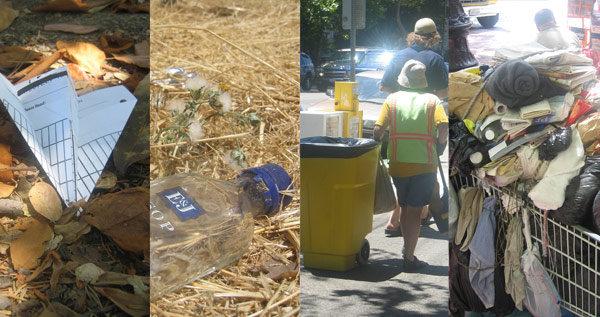
…Trash on a city street also provides a recent history of the presence of its inhabitants. It hints at a bigger, social story of urban places that includes: the density of people using or moving through a space, their social norms, their tastes and habits (what they eat, drink, read, etc), what they value and own (what’s kept, what’s thrown away, what’s reclaimed by others).
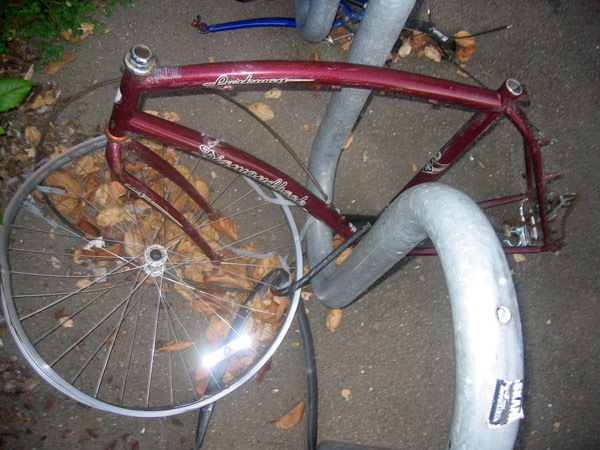
At what point did this once valuable bike become trash?
Digital technologies to automate systems of production, distribution, retail and consumption have existed for 30 years, the UPC or barcode for example. More recently, inexpensive RFID technologies used primarily for inventory tracking during production and shipment are poised to be to be incorporated into nearly every consumer product as they reach a 5 cent cost threshold. Wal-Mart as well as the largest distribution system in the United States, operated by the Department of Defense, have both mandated RFID compliance. With the ability to track individual items through the product lifecycle how will the identification of trash be used? RFID readers in trashcans? Automated refuse sorting? New visualisations of trash movements through the city? How will the heated debate over RFID and privacy play out in this space?

Traschcan Stalking - In-depth Observations
The project fieldwork began with a series of in-depth observations of patterns of usage and traversal, a public place and its trash.
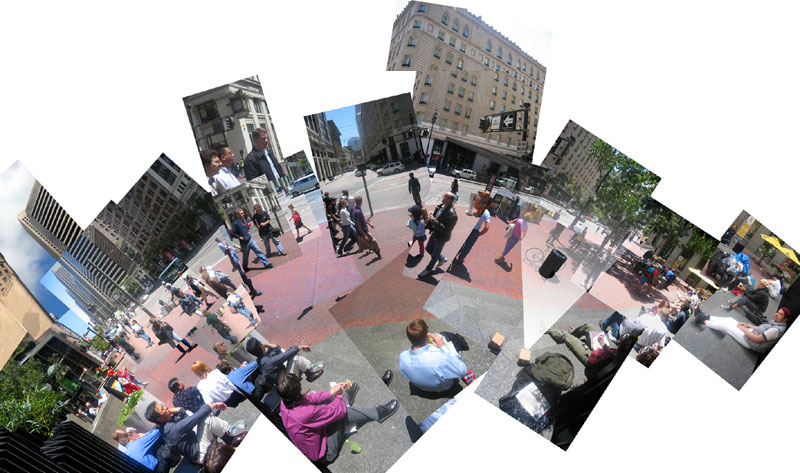
We chose a location in downtown San Francisco, located on a small public plaza in the financial district. A low series of steps surround a local subway exit, adjacent to the main downtown thoroughfare, Market Street. These steps provide popular seating within the plaza for office workers, shoppers and the city’s bike couriers to take a break. Combined with the almost constant flow of passing pedestrian traffic the plaza is very active, a significant place in the city, neither ordinary nor one of many picture postcard scenes.
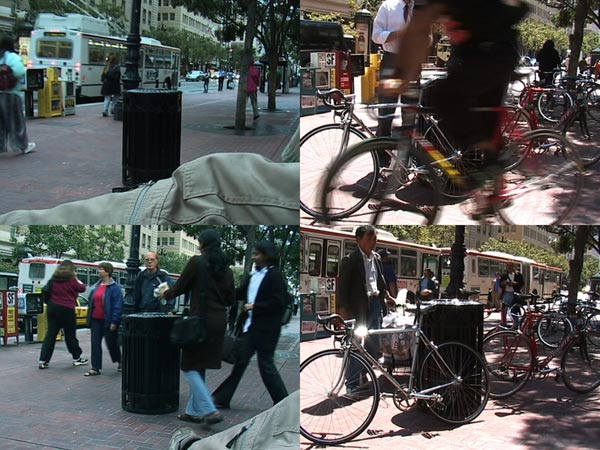
The steps also provided a good vantage point to which to place a small, fixed, and concealed camera to capture activity surrounding a trashcan. Over several sessions at different time of day we recorded the activities (trash in, trash out or other), when they happened, by whom and what path they took through the space.
The trash deposited in this urban trashcan tells a story of ebb and flow, its use chronicles the daily rhythms of the street corner. The contents thrown into the can were rarely surprising, the vast majority of items were food related; usually packaging from nearby cafes, coffee shops and restaurants, other common items included cigarette butts and boxes, newspapers, magazines and plastic bags.
We did see some more surprising patterns that reflect local commerce and politics. For the US, San Francisco's recycling rate exceptionally high at 63%, an army of scavengers collects recycling for small amounts of money from the city’s recycling redemption scheme. Over a quarter of all interactions with the trashcan were not to discard trash. It was a point of exchange, any items of value either food or recycling were removed within minutes of being placed in the can. Interestingly scavengers that searched for food never took recycling and vice versa. On one occasion a Sprite bottle was first observed being dropped vertically into the can, almost full, a couple of minutes later it was picked out, drunk, and thrown back in, finally only five minutes after it was first thrown away the empty bottle was collected by a third individual for recycling using a homemade wire tool to reach in and hook cans and bottles.
Lost Trash
The second intervention stage of the project is adapted from Stanley Milgram's Lost Letter Technique. Lost Trash involved leaving 110 hand-written, stamped and addressed post cards in the streets of San Francisco's city centre, intended to investigate a number of questions:
- What interpretations of value do city dwellers place in the detritus found within the street?
- Will found items be viewed as a lost or trash?
- Are people interested in fragmented narratives that a single piece of trash is able to evoke?
- Will people take responsibility in this “lost trash”?
- Will the levels of interest, responsibility and curiosity vary depending on the location, context, and personal nature of the lost item?
3 kinds of cards were left in 5 contexts: predominantly on (1) Sidewalks and street surfaces, (2) raised surfaces such as benches, newspaper boxes and trashcans, and small number on (3) car windshields, (4) bike and moped baskets, (5) BART underground train.
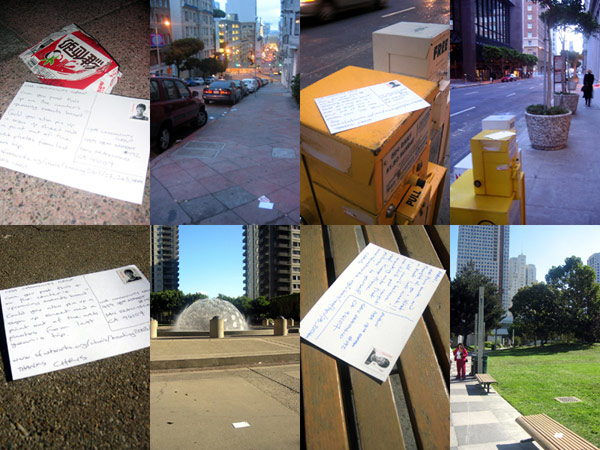
The 3 types of cards were designed to be increasingly personal. All the cards contained a short message discussing a recent event shared between sender and recipient, ending with a URL address, a link to online images from the event. The URL provided the opportunity for deeper investigation into the card's content, a secondary level of recordable action that could further reveal levels of curiosity. Each of the 110 URLs had a different numerical code; these codes were used to log the time, location and context of the dropped cards. Allowing us to track the specific actions taken for each card in one of 4 expected outcomes:
- 1) disregard as trash or pick up and disposed of - no recordable action
- 2) Picked up and returned in the mail - URL not visited
- 3 - Picked up, URL visited (one or more times) card disposed of or kept
- 4 - Picked up, URL viewed (one or more times) and returned in the mail

Card Type A – Personal, individual-to-individual, photographic print

Card Type B – Semi-personal, individual-to-informal group, humorous postcard

Card Type C – Semi-public, individual-to-community group, Boating trip flyer
The proportion of returned cards across the 3 types was fairly consistent, as were the results across the 5 contexts. It soon became apparent that the quality of the study would lie in the specific activity around a minority of the found cards (examples below). There were only 4 URLs hit, 3 were an investigation of the story contained in the personal cards, one of these cards was kept for 6 days until the URL was hit and a further 3 before the card was finally returned, and 2 were kept. Although it is hard to draw clear relationships from our results, a small number of urbanites are curious enough to explore the personal traces left by others in the urban spaces they share - while the majority may have passed by the lost cards as just another piece of trash in the city. Could further probes inspire the majority into the same interest?
The city is full of fragments of information revealing a little glimpse into the lives of strangers, encouraging us to imagine more elaborate stories about them. In this study this became as true for us as it did for those finding the cards. Who had been curious enough to look at the images online and keep the card they found, perhaps sticking it on their fridge. And, just who might have returned the card all the way from Reno?
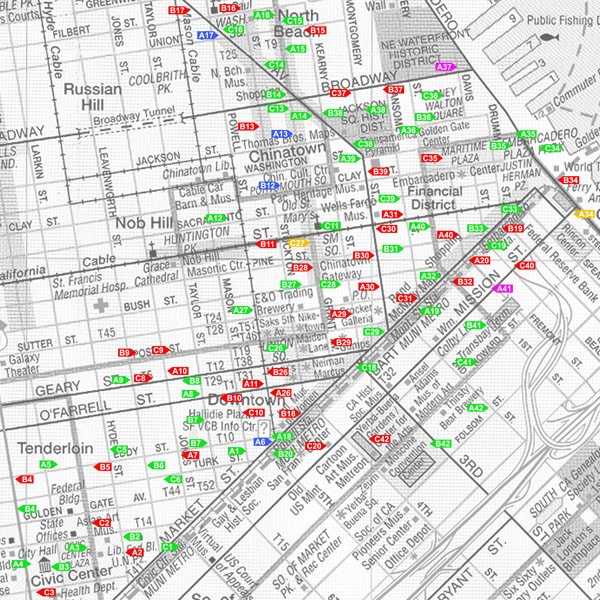
No recordable action
URL not visited, mailed without message
URL not visited, mailed with message
URL visited, not mailed
URL visited, mailed
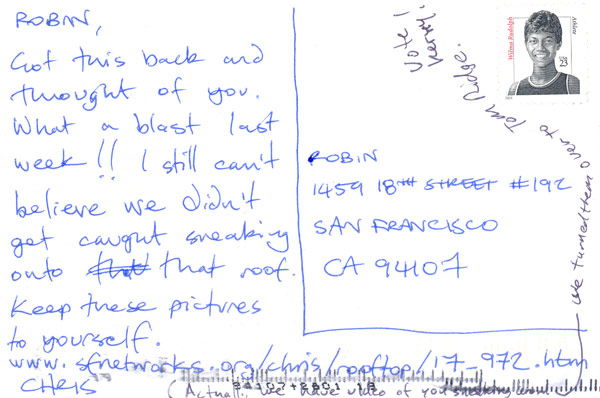
Card A17
Left on a cement bench on Columbus Avenue in North Beach at 8:53am. The card was mailed back that day - 16th August. The finder responded to the card’s personal rooftop story with a cheeky message that read: Actually, we have video footage of you sneaking around, we turned them over to Tom Ridge. Vote Kerry!
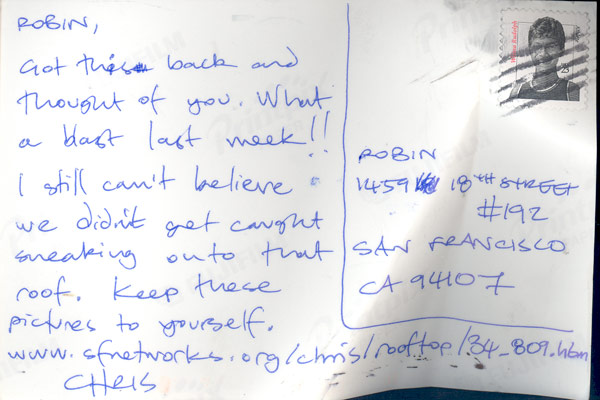
Card A34
Left on a plaza side bench outside an office building and small café - Mission Street near Embarcadero. The card was kept for 6 days until the URL was visited on Saturday 21st August. The card was finally posted back in a very bent and battered state on Tuesday 24th August.
Card B32
Left on a bench on Market Street in an office complex plaza, dropped at 7:02am. It traveled all the way to Reno, Nevada and wasn't mailed back until - 31st August.
Trash Talk - Interviews
Interviews with a broad cross section of San Francisco inhabitants out and about in the city centre, 15 individuals in all. Questions focused on their daily lives, and their observations and opinions of trash in the city. Did they often use a trashcan in that location? Had they ever seen trash that intrigued them? Does a city's trash tell story of its inhabitants? To inspire discussion of the potential narrative of city trash we showed each interviewee image cards. 4 different cards depicted purposefully cheap objects that sit on a threshold of personal value and obsolescence, each left in different places on the street. Was this item lost or trash? Who left it their and why?
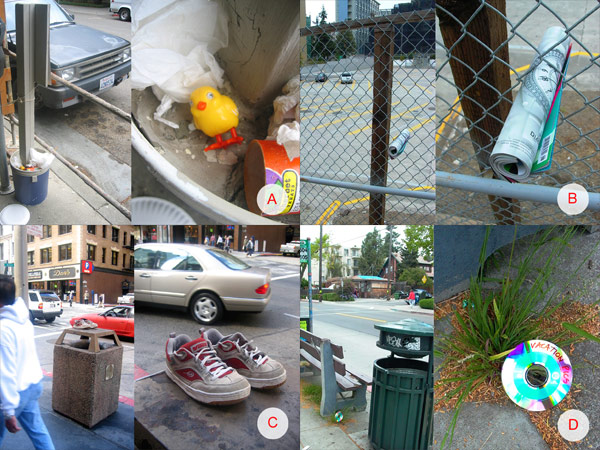
The comments gave us a snap shot of how urbanites relate to city trash. Most of the interviewees said they used a public trashcan at least once a day, often in the same location. While a few showed little interest in the issue, several people took the discussion of trash in the city to a sociological and political conclusion, commenting on modern urbanism, consumption and the desensitisation of urban dwellers to the trash around them. Most people believed there was a story to be told by urban rubbish, giving vivid descriptions of the people and actions that surrounded the image card items. The CD-Rom was commonly regarded as "lost", the shoes as "left for others" or "left for homeless" and the magazine as "litter" left by an inconsiderate person, "probably young".
Joe, a cycle courier interviewed outside Montgomery BART station commented:
The objects that other people throw away have more value than new objects, you know, they've traveled around with different people, they have a story. That’s what gives antiques their value.
Jetsam - Digital Litter
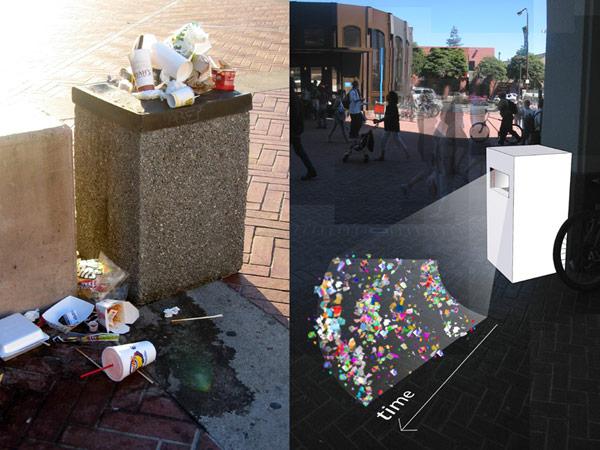
Inspired by the findings of the Trashcan Stalking, Lost Trash and Trash Talk, Jetsam was designed to explore how digital technologies might expose traces of activity in an urban space. Jetsam is undoubtedly an intriguing, intentionally provocative object, exposing city dwellers to a visual history of a place’s detritus. It senses interactions (objects thrown in, taken out, or searched for) and displays what’s changed visually, an image of the new item, or the underlying layer exposed by anything removed. This image falls onto the street, joining animated orbiting strata of rubbish that recedes slowly away from the trashcan over the course of the day. Jetsam's captures a normally hidden element of city life; something contained and removed, and makes a display of it instead.
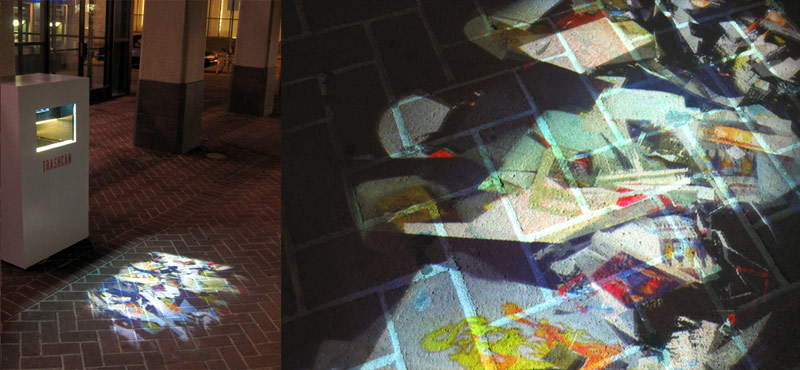
Items also display their weight individually and collectively in the animation. As the can gets full and the total weight inside increases, items orbit faster. The specific weight of an individual item defines its speed of rotation, lighter objects spin round quickly; heavier objects, with greater inertia, turn more slowly.
Passers-by may observe the daily lunchtime rush, or perhaps a layer of blue flyers dropped in by homeward bound clubbers from the previous night. Or, focus may be given to a specific item, a strange inexplicable yet bold object slowly drifting further away as the day goes on? It starts to tell a story of the flow of people and actions. For people who return to this location regularly, Jetsam may encourage an interest in the interrelationship between themselves, urban place, and the fragmentary traces of others.
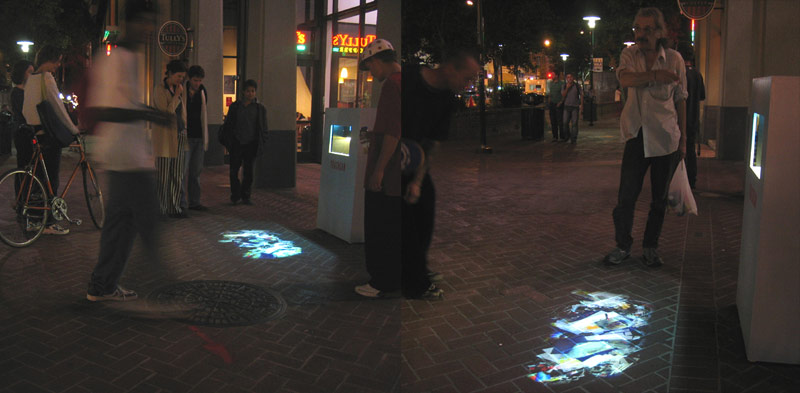
Passers-by took an active interest, exploring the items within the animation. Many people picked out things of interest that had been thrown in and chatted about them with friends and strangers nearby. Declaring "thats a..." or laying claim to an item put in 30 minutes ago that could not be theirs. It was also put to alternative uses. Quickly working out the simple functionality of Jetsam, this guy began publishing his graffiti designs on the street by capturing them under the camera.
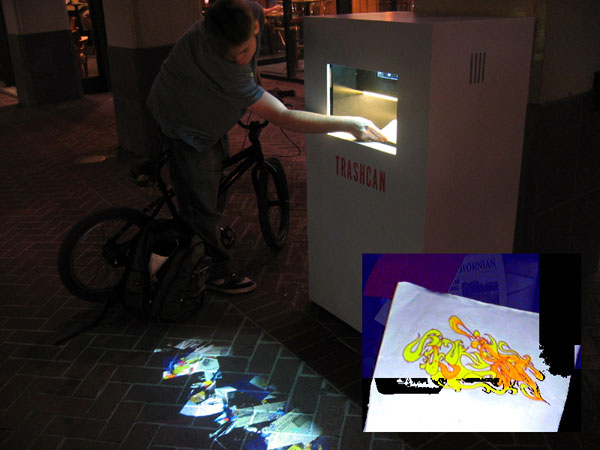
Realistically, we have no grand visions of people documenting and obsessively checking on their local augmented trashcan. However, we do believe such a device that visualises patterns and flows may prompt further reflection on urban life. Inspiring the occasional moment of intrigue and the desire to reveal a little more. The technology used in Jetsam does not require the ownership of personal devices. We do envisage potential further levels of interaction to open up an investigation of Jetsam's potential role in the street.
A concept to extend the opportunities for interaction with curious passers-by. Texting a colour momentarily controls the display of trash orbiting the can. In return, the can follows up by sending back the next piece of trash with that colour.